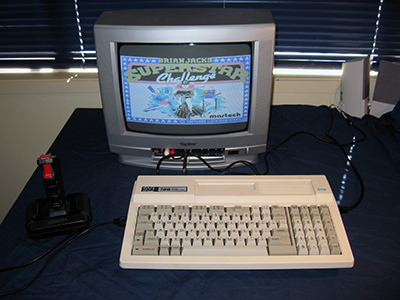| Tweet |
Spectravideo 728 (MSX)
 (Note: Click on the image for a larger view. I also describe this machine in a YouTube video)
(Note: Click on the image for a larger view. I also describe this machine in a YouTube video)
In the early-mid 1980s the home computer market was a mess! A plethora of inexpensive colourful and noisy machines were being released, each one incompatible with all others. Programs and peripherals could not be shared and software writers had to learn a new system every time they wanted to port their works to another machine. This was in contrast to the business side of computing, which was starting to settle down to the unexciting but stable world of 8-bit CP/M or 16-bit IBM-compatibles.
So, here's an idea. Why not develop a standard for 8-bit home computers, one that would specify the necessary hardware and firmware for those cool graphics and sound effects? A standard would give software developers an incentive to write more programs and bring some order to the chaos that was the home computer market. Sounds sensible, yes?
This standard was called MSX and was announced in June 1983. The backers were mostly large Japanese firms eager for consumer pickings and Microsoft. Unfortunately, given technological innovation and intense market competition, "standards" in computing are hard to hold, even today. In the dog-eat-dog world that was home computing back then the MSX standard went nowhere, at least in the market that was most important (i.e. North America and Britain). Home computing continued on its idiosyncratic way, to be dominated by the cheap and cheerful Commodore 64, Spectrums, Amstrads and to a lesser extent (in North America at least), the Apple IIe. Besides, when the first fully compliant MSX machines started to appear in 1985 the "home computer" market was on the decline and was shifting to 16-bit Amigas and Ataris. PC-compatibles were also becoming cheap enough for the home.
The Spectravideo 728 was one of those first fully-compliant MSX computers. As such, it has enough historical significance to earn a place in the collection. The unit seen above is a lovely example in extremely good condition which I picked up free with a haircut! I was generally impressed. It's light yet the keys have a firm feel. It appears really well-made. The unit takes a standard tape deck input, so I've amassed some Internet-sourced software for it.
Another piece of history added to the stash.
Update: The SVI-728 found a new owner in May, 2021 so is no longer with me.
Want to know more about this micro? Google is your friend.
This page last edited 18th July, 2021
| Tweet |